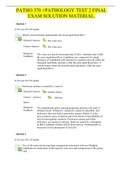Pathology 370 - Study guides, Class notes & Summaries
Looking for the best study guides, study notes and summaries about Pathology 370? On this page you'll find 66 study documents about Pathology 370.
Page 4 out of 66 results
Sort by
PATHO 370 >PATHOLOGY TEST 2 FINAL EXAM SOLUTION MATERIAL.
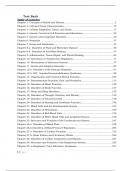
-
Test Bank Porth's Pathophysiology Concepts of Altered Health 10th Edition Norris
- Exam (elaborations) • 412 pages • 2023
-
- $17.99
- + learn more
Test Bank Porth's Pathophysiology Concepts of Altered Health 10th Edition NorrisTable of Contents Chapter 1- Concepts of Health and Disease ....................................................................... 2 Chapter 2- Cell and Tissue Characteristics...................................................................... 10 Chapter 3- Cellular Adaptation, Injury, and Death .......................................................... 17 Chapter 4- Genetic Control of Cell Function and Inheritan...

-
FAMILY NUR NSG5003 Week 10 Final Guide (GRADED A) Questions and Answers | 100% VERIFIED.
- Exam (elaborations) • 53 pages • 2021
-
- $10.99
- + learn more
FAMILY NUR NSG5003 Week 10 Final Guide 1. It is important to not dilate the eye if is suspected. Cataract Macular degeneration Acute closed-angle glaucoma Chronic open-angle glaucoma Quest ion 2. 2. An 18-year-old female patient presents with repeated urinary tract infections. She has no risk factors in her history, and her physical examination is unremarkable. She also has a normal pelvic exam. Which of the following should be obtained if anatomic abnormalities are suspected? Ultrasound of the ...

-
South University, Savannah NSG 5003 Final Exam Week 10 (2019/20) – Test Bank Question with Answers,
- Exam (elaborations) • 53 pages • 2023
-
- $9.99
- + learn more
NSG 5003 Final Exam Week 10 – Question with Answers 1. It is important to not dilate the eye if ____ is suspected. 2. An 18-year-old female patient presents with repeated urinary tract infections. She has no risk factors in her history, and her physical examination is unremarkable. She also has a normal pelvic exam. Which of the following should be obtained if anatomic abnormalities are suspected? 3. The pathophysiological hallmark of ACD is: 4. Which of the following is the most important que...
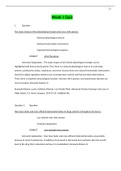
-
NSG6420 QUESTION BANK FOR WEEK 1 TO WEEK 9 QUIZ, FINAL EXAM, AND MIDTERM EXAM (NEWEST-2021): SOUTH UNIVERSITY |100% VERIFIED AND CORRECT ANSWERS|
- Exam (elaborations) • 146 pages • 2021
- Available in package deal
-
- $20.49
- + learn more
NSG6420 QUESTION BANK FOR WEEK 1 TO WEEK 9 QUIZ, FINAL EXAM, AND MIDTERM EXAM (NEWEST-2021): SOUTH UNIVERSITY |100% VERIFIED AND CORRECT ANSWERS| SOUTH UNIVERSITY: NSG 6420 QUESTION BANK FOR WEEK 1 TO WEEK 9 QUIZ, FINAL EXAM, AND MIDTERM EXAM (NEWEST-2021) |100% VERIFIED AND CORRECT ANSWERS| South University NSG6420 Question Bank for Week 1 to Week 9 Quiz, Final Exam, and Midterm Exam NSG6420 Week 1 Quiz Question 1. The major impact of the physiological changes that occur with aging is: ...
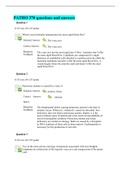
-
Pathology 370 test 2 DB questions and answers
- Exam (elaborations) • 32 pages • 2021
-
- $14.49
- + learn more
0.125 out of 0.125 points Which vessel normally demonstrates the most rapid blood flow? Selected Answer: c. The vena cava Correct Answer: c. The vena cava Response Feedback: The vena cava has the most rapid rate of flow. Arterioles don’t offer the most rapid blood flow. Capillaries are composed of a single thickness of endothelial cells attached to a protein network called the basement membrane and don’t offer the most rapid blood flow. A venule begins where the arteriole end...

-
NSG 6435 Final Exam Study Guide 2 (VERIFIED)
- Exam (elaborations) • 70 pages • 2021
-
- $18.29
- + learn more
1. Expected inc in wt: birth-3 mo 2. Expected inc in wt: 3-6 mo 3. Expected inc in wt: 6-12 mo 4. Expected inc in wt: 1-2 years 5. Expected inc in wt: 2 yr-adolescence 6. Expected inc in height: 0-12 mo 7. Expected inc in height: 13-24 mo 8. Expected inc in height: 2 years to adolescence 9. When does head growth occur? 10. Expected inc in head circumference: 0-2mo 11. Expected inc in head circumference: 2-6 mo 12. Expected inc in head circumference: by 12 mo 1...

-
PATHOPHYSIOLOGY 370 FINAL EXAM STUDY GUIDE.
- Other • 57 pages • 2021
-
- $10.99
- + learn more
Chapter 1: PATHOPHYSIOLOGY 370 FINAL EXAM STUDY GUIDE 1. Etiology: study of causes or reasons for a particular injury. Idiopathic (unknown) vs Iatrogenic (unintended/unwanted medical treatment ). Risk Factor: a factor that increases the likelihood of disease. 2. Pathogenesis: development or evolution of disease from initial stimulus to ultimate expression of manifestations of the disease. 3. Clinical Manifestations: Signs (objective) vs Symptoms (subjective). 4. Stages and Clinical Course: Laten...
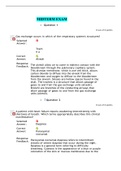
-
Pathology 370 midterm exam correct questions and answers 2021 latest edition
- Exam (elaborations) • 57 pages • 2021
-
- $20.49
- + learn more
Gas exchange occurs in which of the respiratory system's structures? Selected Answer: Trache a Correct Answer: Alveoli Response Feedback: The alveoli allow air to come in indirect contact with the bloodstream through the pulmonary capillary system. This alveolar membrane, which is one cell thick, allows carbon dioxide to diffuse into the alveoli from the bloodstream and oxygen to diffuse to the bloodstream from the alveoli. Sinuses are hollow spaces found in the skull. The trachea ...

-
NSG 6435 Final Exam Study Guide 2 Latest Update 2021-100% VERIFIED CORRECT(500+ Questions with ANSWERS)
- Exam (elaborations) • 70 pages • 2021
-
- $17.49
- + learn more
1. Expected inc in wt: birth-3 mo 2. Expected inc in wt: 3-6 mo 3. Expected inc in wt: 6-12 mo 4. Expected inc in wt: 1-2 years 5. Expected inc in wt: 2 yr-adolescence 6. Expected inc in height: 0-12 mo 7. Expected inc in height: 13-24 mo 8. Expected inc in height: 2 years to adolescence 9. When does head growth occur? 10. Expected inc in head circumference: 0-2mo 11. Expected inc in head circumference: 2-6 mo 12. Expected inc in head circumference: by 12 mo 1...

How did he do that? By selling his study resources on Stuvia. Try it yourself! Discover all about earning on Stuvia

